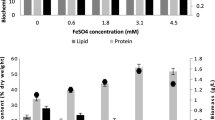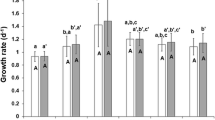Abstract
In this study, the effect of sodium acetate (C2H3NaO2) and sodium nitrate (NaNO3) concentrations on proximate and fatty acid composition of Ulva rigida (C. Agardh) was studied. Two trials were carried out. In the first experiment, the C2H3NaO2 was used as an organic carbon sources and five different concentrations of C2H3NaO2 were added; 0.25, 0.5, 1, 2, and 3 g/l. In the second trial, at the beginning of the experiment, 1 g/l C2H3NaO2 was added all groups, but the nitrogen regimes of the groups were changed. Five different nitrogen concentrations were used; 0.2 g/(l d), 0.3 g/(l d), 0.4 g/(l d), 0.6 g/(l d), and 0.11 g/(l d). According to our results, U. rigida cultivated with C2H3NaO2 and NaNO3 can successfully be used for both animal and human nutrition. The fatty acid methyl esters results showed that fatty acid contents of U. rigida were influenced by carbon (C2H3NaO2) and nitrogen (NaNO3) concentrations. The saturated fatty acids levels of U. rigida cultured in different NaNO3 concentrations were very high. The results indicated that C2H3NaO2 and NaNO3 addition during the culturing had considerable affects on proximate and fatty acid composition of the U. rigida. Using both C2H3NaO2 and NaNO3 offers a balanced fatty acid composition for both animal and human nutrition.
Similar content being viewed by others
References
Ak İ (2012) Effect of an organic fertilizer on growth of blue-green alga Spirulina platensis. Aquac Int 20(3):413–422
Ak İ, Öztaşkent C, Topçu N (2011) Effect of different carbon sources on green algae Ulva rigida (C. Agardh) culture. Ege J Fish Aqua Sci 28(3):89–93
AOAC (2000) Official methods of analysis of association of official analytical chemists international, 17th edn. AOAC International, Arlington
Chen F, Johns M (1991) Effect of C/N ratio and aeration on the fatty acid composition of heterotrophic Chlorella sorokiniana. J Appl Phycol 3(3):203–209
Colakoglu F, Ormanci H, Cakir F (2011) Effect of marination and smoking on lipid and fatty acid composition of thornback ray (Raja clavata) and spiny dogfish (Squalis acanthias). Eur Food Res Technol 232(6):1069–1075
Cruz-Suárez LE, León A, Peña-Rodríguez A, Rodríguez-Peña G, Moll B, Ricque-Marie D (2010) Shrimp/Ulva co-culture: a sustainable alternative to diminish the need for artificial feed and improve shrimp quality. Aquaculture 301(1–4):64–68
Dawczynski C, Schubert R, Jahreis G (2007) Amino acids, fatty acids, and dietary fibre in edible seaweed products. Food Chem 103(3):891–899
Erkkilä AT, Lehto S, Pyörälä K, Uusitupa MI (2003) n-3 fatty acids and 5-y risks of death and cardiovascular disease events in patients with coronary artery disease. Am Soc Clin Nutr 78(1):65–71
FAO (2011) The state of world fisheries and aquaculture. Food and Agriculture Organization of the United Nations, Rome
Fleurence J (1999) Seaweed proteins: biochemical, nutritional aspects and potential uses. Trends Food Sci Technol 10(1):25–28
Fleurence J, Morançais M, Dumay J, Decottignies P, Turpin V, Munier M, Garcia-Bueno N, Jaouen P (2012) What are the prospects for using seaweed in human nutrition and for marine animals raised through aquaculture? Trends Food Sci Technol 27(1):57–61
Floreto EAT, Hirata H, Ando S, Yamasaki S (1993a) Effects of temperature, light intensity, salinity and source of nitrogen on the growth, total lipid and fatty acid composition of Ulva pertusa Kjellman (Chlorophyta). Bot Mar 36(2):149–158
Floreto EAT, Hirata H, Ando S, Yavuz S (1993b) Fatty acid composition of Ulva pertusa Kjellman (Chlorophyta) and Gracilaria incurvata Okamura (Rhodophyta) in Japanese coastal waters. Bot Mar 36(3):217–222
Folch J, Lees M, Stanley GHS (1957) A simple method for the isolation and purification of total lipids from animal tissues. J Biol Chem 226:497–509
Gómez Pinchetti J, del Campo Fernández E, Moreno Díez P, Reina G (1998) Nitrogen availability influences the biochemical composition and photosynthesis of tank-cultivated Ulva rigida (Chlorophyta). J Appl Phycol 10(4):383–389
Gordillo FJL, Jiménez C, Goutx M, Niell X (2001) Effects of CO2 and nitrogen supply on the biochemical composition of Ulva rigida with especial emphasis on lipid class analysis. J Plant Physiol 158(3):367–373
Güroy D, Güroy B, Merrifield DL, Ergün S, Tekinay AA, Yiğit M (2011) Effect of dietary Ulva and Spirulina on weight loss and body composition of rainbow trout, Oncorhynchus mykiss (Walbaum), during a starvation period. J Anim Physiol Anim Nutr 95(3):320–327
Hanisak MD (1983) The nitrogen relationships of marine macroalgae. In: Carpenter EJ, Capone TH (eds) Nitrogen in the marine environment. Academic Press, New York, pp 699–730
Johnson MK, Johnson EJ, MacElroy RD, Speer HL, Bruff BS (1968) Effects of salts on the halophilic alga Dunaliella viridis. J Bacteriol 95(4):1461–1468
Kumar M, Kumari P, Gupta V, Anisha PA, Reddy CRK, Jha B (2010) Differential responses to cadmium induced oxidative stress in marine macroalga Ulva lactuca (Ulvales, Chlorophyta). Biometals 23(2):315–325
Lahaye M, Gomez-Pinchetti J-L, del Rio MJ, Garcia-Reina G (1995) Natural decoloration, composition and increase in dietary fibre content of an edible marine algae, Ulva rigida (Chlorophyta), grown under different nitrogen conditions. J Sci Food Agric 68(1):99–104
Lobban CS, Harrison PJ (1994) Seaweed ecology and physiology. Cambridge University press, Cambridge, p 366
Mandle VS, Salunke SD, Gaikwad SM, Dande KG, Patil MM (2012) Study of nutritional value of some unique leafy vegetables grown in Latur district. J Anim Sci Adv 2(3.1):296–298
Marinho-Soriano E, Fonseca PC, Carneiro MAA, Moreira WSC (2006) Seasonal variation in the chemical composition of two tropical seaweeds. Bioresour Technol 97(18):2402–2406
Neori A, Cohen I, Gordin H (1991) Ulva lactuca biofilters for marine fishpond effluents. II. Growth rate, yield and C: N ratio. Bot Mar 3:483–489
Neori A, Ragg NLC, Shpigel M (1998) The integrated culture of seaweed, abalone, fish and clams in modular intensive land-based systems: II. Performance and nitrogen partitioning within an abalone (Haliotis tuberculata) and macroalgae culture system. Aquac Eng 17(4):215–239
Ortiz J, Romero N, Robert P, Araya J, Lopez-Hernández J, Bozzo C, Navarrete E, Osorio A, Rios A (2006) Dietary fiber, amino acid, fatty acid and tocopherol contents of the edible seaweeds Ulva lactuca and Durvillaea antarctica. Food Chem 99(1):98–104
Paul A, Southgate D (1978) McCance and Widdowson’s the composition of foods. Medical research council special report series No: 297. HMSO, London
Peña-Rodríguez A, Mawhinney TP, Ricque-Marie D, Cruz-Suárez LE (2011) Chemical composition of cultivated seaweed Ulva clathrata (Roth) C. Agardh. Food Chem 129(2):491–498
Rustan AC, Drevon CA (2001) Fatty acids: structures and properties. In: encyclopedia of life sciences. Nature Publishing, London. http://www.els.net
Sanina NM, Goncharova SN, Kostetsky EY (2004) Fatty acid composition of individual polar lipid classes from marine macrophytes. Phytochemistry 65(6):721–730
Smit A, Robertson B, Preez D (1996) Influence of ammonium-N pulse concentrations and frequency, tank condition and nitrogen starvation on growth rate and biochemical composition of Gracilaria gracilis. J Appl Phycol 8(6):473–481
Sven B, Eshel A (1983) Photosynthesis of Ulva sp. I. Effects of desiccation when exposed to air. J Exp Mar Biol Ecol 70(1):91–97
Tabarsa M, Rezaei M, Ramezanpour Z, Waaland JR (2012) Chemical compositions of the marine algae Gracilaria salicornia (Rhodophyta) and Ulva lactuca (Chlorophyta) as a potential food source. J Sci Food Agric 92(12):2500–2506
Toskas G, Hund R-D, Laourine E, Cherif C, Smyrniotopoulos V, Roussis V (2011) Nanofibers based on polysaccharides from the green seaweed Ulva rigida. Carbohydr Polym 84(3):1093–1102
Turpin DH (1991) Effects of inorganic N availability on algal photosynthesis and carbon metabolism. J Phycol 27(1):14–20
UIPAC (1979) Standards methods for the analysis of oils, fats ad derivatives. Pergamon Press, Oxford
Vergara J, Niell FX, Torres M (1993) Culture of Gelidium sesquipedale (Clem.) Born.et Thur. in a chemostat system. Biomass production and metabolic responses affected by N flow. J Appl Phycol 5(4):405–415
Yaich H, Garna H, Besbes S, Paquot M, Blecker C, Attia H (2011) Chemical composition and functional properties of Ulva lactuca seaweed collected in Tunisia. Food Chem 128(4):895–901
Acknowledgments
The authors are indebted to Bayram Kızılkaya and Fikret Çakır for helpful advice concerning the FAME analyses.
Author information
Authors and Affiliations
Corresponding author
Rights and permissions
About this article
Cite this article
Ak, İ., Öztaşkent, C., Özüdoğru, Y. et al. Effect of sodium acetate and sodium nitrate on biochemical composition of green algae Ulva rigida . Aquacult Int 23, 1–11 (2015). https://doi.org/10.1007/s10499-014-9793-3
Received:
Accepted:
Published:
Issue Date:
DOI: https://doi.org/10.1007/s10499-014-9793-3




